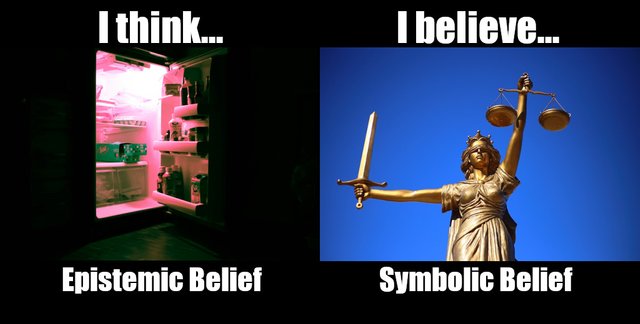An Outsider’s Idea of an Insider
(cross-posted from my Substack)
An Outsider’s Idea of an Insider
Outsiders’ misunderstanding of symbolic beliefs: bug or feature?
I recently read an interesting philosophy paper, Symbolic belief in social cognition by Evan Westra (h/t to Dan Williams of the Conspicuous Cognition Substack who tweeted about it). The topic of the paper is that there seem to be two types of beliefs, epistemic beliefs which are beliefs about straightforward facts in the world, and symbolic beliefs which are about religion, morality, politics, or social identity, which seem to have a more complicated relationship to whether or not they are literally true. The paper acknowledges that there there are different schools of thought about whether these are two different things in the mind/brain or whether the same mechanism underlies both, but identifies that we act as if they are two different things in our “folk psychology” of common-sense interactions with others, so even if they are ultimately the same we would still need to understand the mechanisms that seem to lead to two different kinds of thing at the social level. One way of seeing the distinction is that we tend to use the verbs think and believe with different categories: I think there is milk in the refrigerator, I believe the accused is innocent until proven guilty.

The paper uses the puzzling beliefs of conspiracy theorists as something to consider in this framework:
All of these authors seem to agree that such attitudes are mostly strongly activated in very specific ritual and social contexts, but otherwise have limited epistemic and practical effects. Take Mercier and Altay's recent example of the “PizzaGate” conspiracy theory that Democrats were operating a satanic pedophile ring in the basement of the Comet Ping Pong restaurant in Washington DC, which was believed by millions of people in the run-up to the 2016 US Presidential Election. This conspiracy theory rose to international prominence when a lone individual armed with an assault rifle showed up at Comet Ping Pong attempting to liberate the children trapped in the cellar, and was promptly arrested. While this individual appeared to treat the PizzaGate theory as factual, he was the exception that proved the rule: the vast majority of people who believed this theory did not attempt to intervene, as one might expect of a person who truly believed that children were being abused there. Instead, they contented themselves with sharing the conspiracy theory amongst each other and posting negative reviews on the restaurant's Google page (Mercier & Altay, 2022). This suggests that for their adherents, the real function of the PizzaGate conspiracy theory was tied to the social experiences it engendered rather than a genuine attempt to uncover facts about the world (Wagner-Egger et al., 2022).
The thing that strikes me as interesting here is that the guy who took a gun to Comet Ping Pong is considered a weird outlier even by other conspiracy theorists. He wasn’t just violating the norms of regular society, he was also violating the norms of that subculture. But we outsiders are inclined to agree with propositions like “that’s what you would do if you actually believed that”.
The paper makes an argument about the “mind reading” function of epistemic beliefs and the “mind shaping” (norm enforcing) aspect of symbolic beliefs.
As a result, it's likely that we often mistakenly attribute epistemic beliefs to outsiders instead of symbolic beliefs. This then leads us to infer that these individuals must be either ignorant, irrational, or dishonest (e.g., Doherty et al., 2019, 2022): how else could we explain why those people come to have such outlandish beliefs? But this is often a misunderstanding, since symbolic belief discourse does not aim at truth. Conversely, understanding the real function of symbolic beliefs might foster better intergroup understanding. Even if some beliefs appear extreme or alien from the outside, from inside of a community they are experienced as an ordinary part of how one relates to one's peers. Grasping the non-epistemic role of these beliefs – and the fact that they probably have analogues in one's own ingroup – could help to reduce false impressions of epistemic and political polarization (Fernbach & Van Boven, 2022; c.f. Joshi, 2020).
I think part of the story could be that the disconnect between the outsider who thinks the insider believes something crazy and the insider who acts in a “going about life in a not-conspicuously-crazy way” might be that the insider has a more nuanced understanding of that belief, because it’s also connected to other beliefs that are socially stable when aggregated. For example, a Pizzagate conspiracy theorist may also believe that conventional institutions of authority are compromised and it would be both ineffective and dangerous to try to do anything about it yourself, in which case just watching and waiting would be the normative thing to do.[1] Someone with animistic beliefs may believe that angry spirits are a big problem, and also that they’re lucky to have access to a shaman who is a specialist in dealing with that sort of thing. The difference between the two classes of beliefs identified in the paper may be analogous to the difference between solitary animals and herd/pack animals – whether you expect them to operate independently or expect them to operate within groups of related others. (To be clear, saying that something is complex and nuanced isn’t the same as saying it’s correct! I’m sure there were “four humors” theorists and practitioners with extremely complex and subtle views that we now rightly reject because they were just wrong at the base level.)

And the misunderstood-by-outsiders aspect may not be just a coincidence, but part of a mechanism of action. Like with slang or inside jokes, if you only have a shallow or partial understanding you may end up engaging awkwardly or disfluently, which marks you as an outsider or low-status neophyte to the insiders. Being able to tell who is who and where they stand can be useful to a social animal. The garish and gaudy Donald Trump is famously derided as “the poor person’s idea of a rich person”, since the typical member of the upper class tends toward understated elegance. Thinking that conspiracy theorists or believers in the supernatural ought to be acting outlandishly may be an analogous “outsider’s idea of an insider” – a not-quite-accurate over-extrapolation from limited information.
Relevance to Tabletop RPGs
I find this topic interesting not just because it speaks to some things happening in politics and culture broadly, but also because it strikes me as relevant to RPGs. My current working model of how games work is that players temporarily engage with the “local values frame” of the game, so understanding the underlying architecture of how people believe things and orient themselves to values seems relevant to that. Also, it seems that various ideas, trends, fads, etc., seem to influence the culture around RPGs or the various subcultures within it, so it’s worth understanding the dynamic. For example, the way that “convention gaming” had a powerful impact on shaping the Forge/Story Games scene, or how the antipathy toward explicit game design in the OSR scene provides a cultural rallying point but impacts what tools they can have in their toolbox. The kind of TTRPG play I’m interested in isn’t compatible with some of the popular schools of thought that seem to dominate the online RPG culture, so understanding the relationship between beliefs and subcultures seems relevant to figuring out how to deal with that. And as someone who has at least one foot in old Forge theory, I can see how misunderstandings of poorly-explained ideas, obscurantism and status games by insiders, and polarizing agitation by outsiders all seemed to contribute to turning a lot of RPG Design and RPG Theory discussion topics into politically fraught minefields.
[1] Plus they probably have a lot of the same norms against becoming vigilantes as the average person.